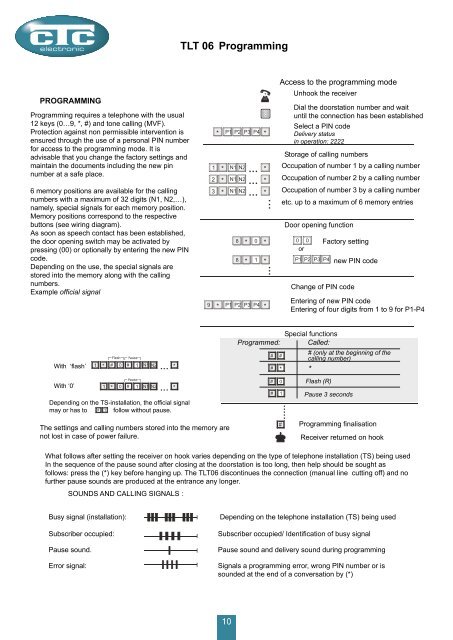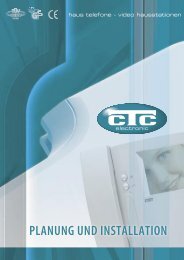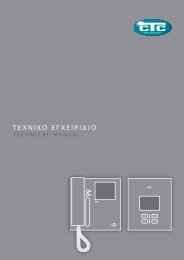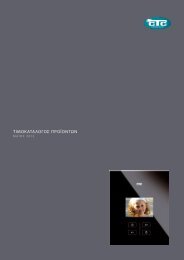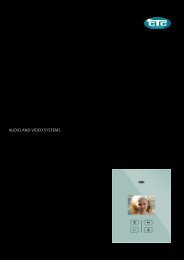Technical Manual UK.indd - CTC
Technical Manual UK.indd - CTC
Technical Manual UK.indd - CTC
Create successful ePaper yourself
Turn your PDF publications into a flip-book with our unique Google optimized e-Paper software.
electronic<br />
TLT 06 Programming<br />
PROGRAMMING<br />
Programming requires a telephone with the usual<br />
12 keys (0…9, *, #) and tone calling (MVF).<br />
Protection against non permissible intervention is<br />
ensured through the use of a personal PIN number<br />
for access to the programming mode. It is<br />
advisable that you change the factory settings and<br />
maintain the documents including the new pin<br />
number at a safe place.<br />
6 memory positions are available for the calling<br />
numbers with a maximum of 32 digits (N1, N2,…),<br />
namely, special signals for each memory position.<br />
Memory positions correspond to the respective<br />
buttons (see wiring diagram).<br />
As soon as speech contact has been established,<br />
the door opening switch may be activated by<br />
pressing (00) or optionally by entering the new PIN<br />
code.<br />
Depending on the use, the special signals are<br />
stored into the memory along with the calling<br />
numbers.<br />
Example official signal<br />
2<br />
3<br />
* P1 P2 P3 P4 *<br />
1 * N1 N2<br />
*<br />
*<br />
N1 N2<br />
N1 N2<br />
*<br />
*<br />
*<br />
*<br />
8 * 0 *<br />
0 0<br />
or<br />
8<br />
...<br />
...<br />
...<br />
.<br />
.<br />
.<br />
1<br />
*<br />
. . .<br />
9 * P1 P2 P3 P4 *<br />
Access to the programming mode<br />
Unhook the receiver<br />
Dial the doorstation number and wait<br />
until the connection has been established<br />
Select a PIN code<br />
Delivery status<br />
in operation: 2222<br />
Storage of calling numbers<br />
Occupation of number 1 by a calling number<br />
Occupation of number 2 by a calling number<br />
Occupation of number 3 by a calling number<br />
etc. up to a maximum of 6 memory entries<br />
Door opening function<br />
Factory setting<br />
P1 P2 P3 P4 new PIN code<br />
Change of PIN code<br />
Entering of new PIN code<br />
Entering of four digits from 1 to 9 for P1-P4<br />
With ‘flash’<br />
With ‘0’<br />
1 * # 0 # 1 N1 N2<br />
...<br />
*<br />
1 * 0 # 1 N1 ..<br />
. N2 *<br />
Depending on the TS-installation, the official signal<br />
may or has to # 1 follow without pause.<br />
The settings and calling numbers stored into the memory are<br />
not lost in case of power failure.<br />
Special functions<br />
Programmed: Called:<br />
# # # (only at the beginning of the<br />
calling number)<br />
# * *<br />
#<br />
0<br />
# 1<br />
. . . .<br />
.<br />
#<br />
Flash (R)<br />
Pause 3 seconds<br />
Programming finalisation<br />
Receiver returned on hook<br />
What follows after setting the receiver on hook varies depending on the type of telephone installation (TS) being used<br />
In the sequence of the pause sound after closing at the doorstation is too long, then help should be sought as<br />
follows: press the (*) key before hanging up. The TLT06 discontinues the connection (manual line cutting off) and no<br />
further pause sounds are produced at the entrance any longer.<br />
SOUNDS AND CALLING SIGNALS :<br />
Busy signal (installation):<br />
Subscriber occupied:<br />
Pause sound.<br />
Error signal:<br />
Depending on the telephone installation (TS) being used<br />
Subscriber occupied/ Identification of busy signal<br />
Pause sound and delivery sound during programming<br />
Signals a programming error, wrong PIN number or is<br />
sounded at the end of a conversation by (*)<br />
10<br />
10


